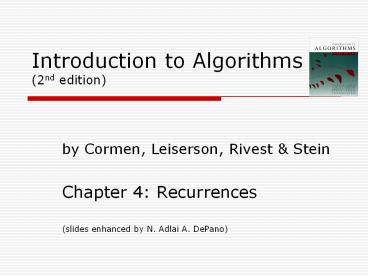Introduction to Algorithms (2nd edition) - PowerPoint PPT Presentation
Title:
Introduction to Algorithms (2nd edition)
Description:
A recurrence is an equation or inequality that describes a function ... Inductive Proof. In particular, for n = k/2 , the inductive hypothesis should hold, i.e. ... – PowerPoint PPT presentation
Number of Views:115
Avg rating:3.0/5.0
Title: Introduction to Algorithms (2nd edition)
1
Introduction to Algorithms(2nd edition)
- by Cormen, Leiserson, Rivest Stein
- Chapter 4 Recurrences
- (slides enhanced by N. Adlai A. DePano)
2
Overview
- Define what a recurrence is
- Discuss three methods of solving recurrences
- Substitution method
- Recursion-tree method
- Master method
- Examples of each method
3
Definition
- A recurrence is an equation or inequality that
describes a function in terms of its value on
smaller inputs. - Example from MERGE-SORT
4
Technicalities
- Normally, independent variables only assume
integral values - Example from MERGE-SORT revisited
- For simplicity, ignore floors and ceilings
often insignificant
5
Technicalities
- Boundary conditions (small n) are also glossed
over
- Value of T(n) assumed to be small constant for
small n
6
Substitution Method
- Involves two steps
- Guess the form of the solution.
- Use mathematical induction to find the constants
and show the solution works. - Drawback applied only in cases where it is easy
to guess at solution - Useful in estimating bounds on true solution even
if latter is unidentified
7
Substitution Method
- Example T(n) 2T(?n/2?) n
- Guess T(n) O(n lg n)
- Prove by induction T(n) ? cn lg n
for suitable cgt0.
8
Inductive Proof
- Well not worry about the basis case for the
moment well choose this as needed clearly we
have T(1) ?(1) ? cn lg n
- Inductive hypothesis For values of n lt k the
inequality holds, i.e., T(n) ? cn lg
nWe need to show that this holds for n k as
well.
9
Inductive Proof
- In particular, for n ?k/2?, the inductive
hypothesis should hold, i.e.,
T(?k/2?) ? c ?k/2? lg ?k/2?
- The recurrence gives us T(k)
2T(?k/2?) k
- Substituting the inequality above yields
T(k) ? 2c ?k/2? lg ?k/2? k
10
Inductive Proof
- Because of the non-decreasing nature of the
functions involved, we can drop the floors and
obtain T(k) ? 2c (k/2) lg (k/2)
k
- Which simplifies to T(k) ? ck (lg k
? lg 2) k
Or, since lg 2 1, we have T(k) ? ck lg
k ? ck k ck lg k (1? c)k
So if c ? 1, T(k) ? ck lg k Q.E.D.
11
Recursion-Tree Method
- Straightforward technique of coming up with a
good guess - Can help the Substitution Method
- Recursion tree visual representation of
recursive call hierarchy where each node
represents the cost of a single subproblem
12
Recursion-Tree Method
13
Recursion-Tree Method
14
Recursion-Tree Method
15
Recursion-Tree Method
16
Recursion-Tree Method
- Gathering all the costs together
17
Recursion-Tree Method
T(n)
T(n/3) T(2n/3) O(n)
18
Recursion-Tree Method
- An overestimate of the total cost
- Counter-indications
- Notwithstanding this, use as guess
19
Substitution Method
- Recurrence T(n) T(n/3) T(2n/3)
cn
- Guess T(n) O(n lg n)
- Prove by induction T(n) ? dn lg n
for suitable dgt0 (we already use c)
20
Inductive Proof
- Again, well not worry about the basis case
- Inductive hypothesis For values of n lt k the
inequality holds, i.e., T(n) ? dn lg
nWe need to show that this holds for n k as
well.
- In particular, for n k/3, and n 2k/3, the
inductive hypothesis should hold
21
Inductive Proof
- That is T(k/3) ? d k/3 lg k/3
T(2k/3) ? d 2k/3 lg 2k/3
- The recurrence gives us T(k) T(k/3)
T(2k/3) ck
- Substituting the inequalities above yields T(k)
? d (k/3) lg (k/3) d (2k/3) lg (2k/3) ck
22
Inductive Proof
- Expanding, we getT(k) ? d (k/3) lg k ? d (k/3)
lg 3 d (2k/3) lg k ? d (2k/3)
lg(3/2) ck
- Rearranging, we get T(k) ? dk lg k ? d(k/3) lg
3 (2k/3) lg(3/2) ckT(k) ? dk lg k ? dklg 3
? 2/3 ck
- When d?c/(lg3 ? (2/3)), we should have the
desired T(k) ? dk lg k
23
Master Method
- Provides a cookbook method for solving
recurrences - Recurrence must be of the form
where a?1 and bgt1 are constants and f(n) is
an asymptotically positive function.
24
Master Method
- Theorem 4.1
- Given the recurrence previously defined, we have
- If f(n) O(n logba??) for some constant
?gt0, then T(n) ?(n logba) - If f(n) ?(n logba), then T(n) ?(nlogba
lg n)
25
Master Method
- If f(n) ?(n logba?) for some constant
?gt0, and if af(n/b) ?
cf(n) for some constant clt1 and all
sufficiently large n, then T(n) ?(f(n))
26
Example
- Estimate bounds on the following recurrence
- Use the recursion tree method to arrive at a
guess then verify using induction
- Point out which case in the Master Method this
falls in
27
Recursion Tree
- Recurrence produces the following tree
28
Cost Summation
- Collecting the level-by-level costs
- A geometric series with base less than one
converges to a finite sum, hence, T(n) ?(n2)
29
Exact Calculation
- If an exact solution is preferred
- Using the formula for a partial geometric series
30
Exact Calculation
- Solving further
31
Master Theorem (Simplified)































